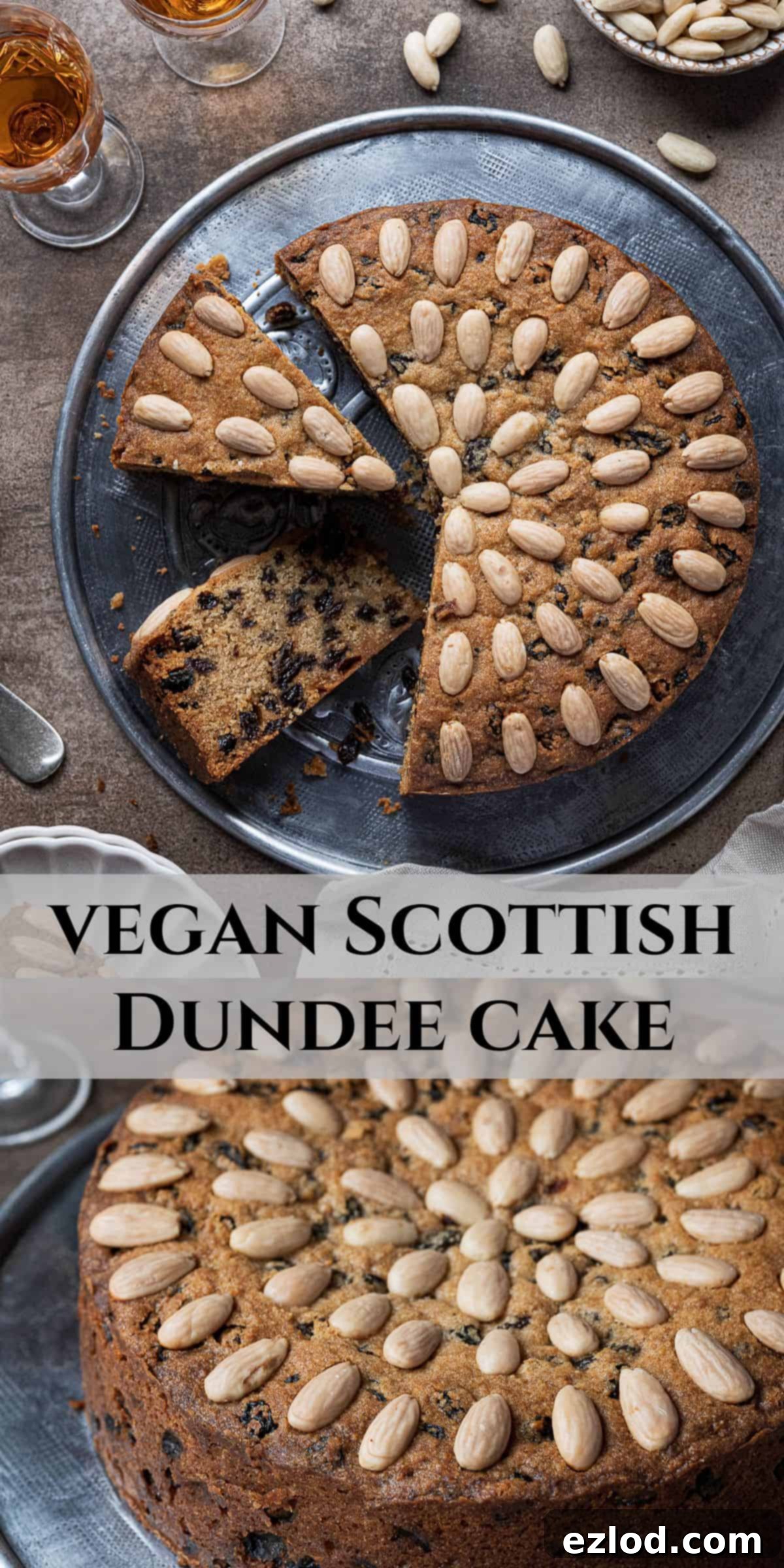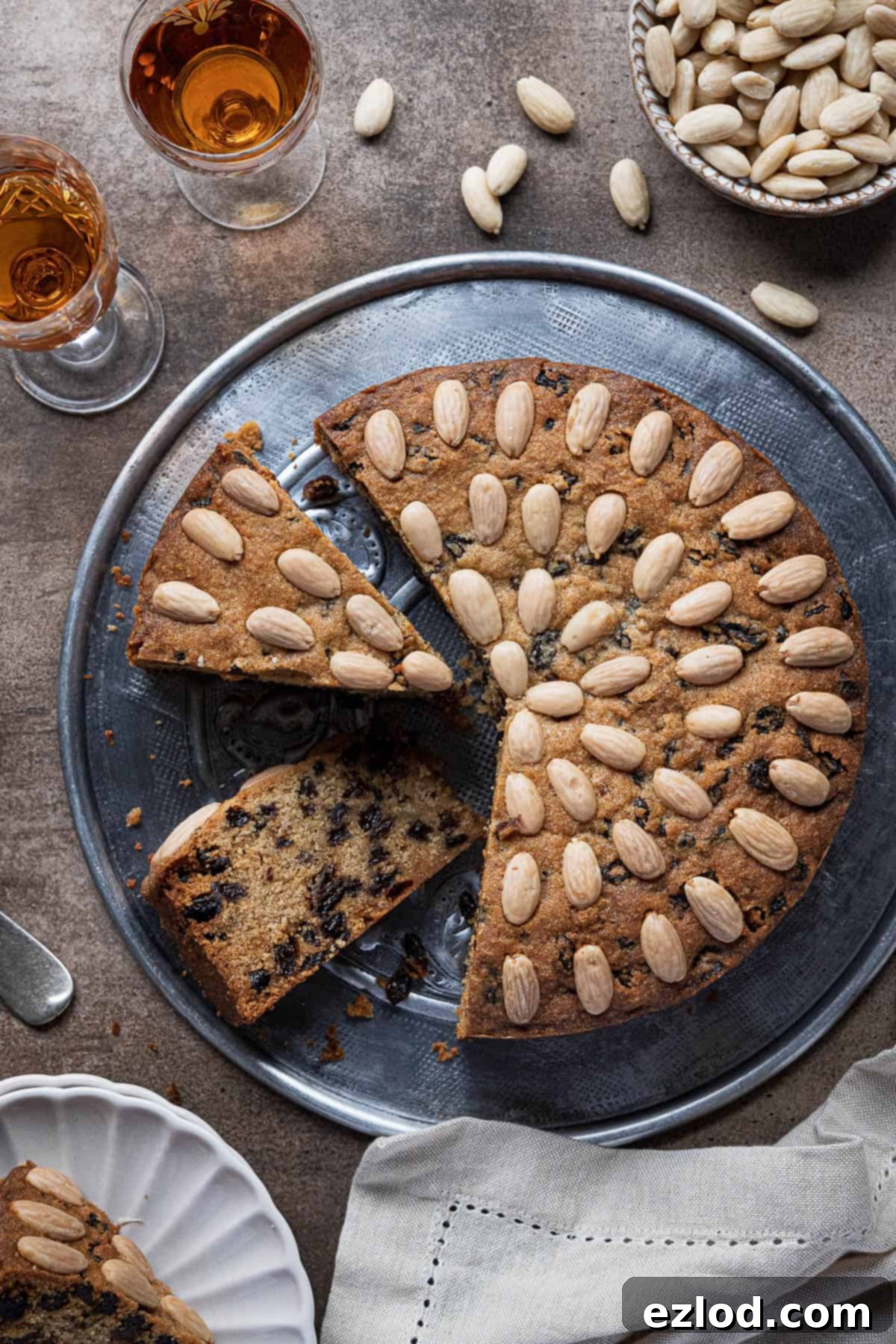Exquisite Vegan Dundee Cake: A Traditional Scottish Delight Reimagined
Discover the joy of baking this utterly delicious vegan Dundee cake – a classic Scottish fruit cake made easy and entirely plant-based. It offers a wonderfully lighter alternative to heavier Christmas cakes, perfect for any time of year.
Crafted with aromatic Seville orange marmalade and rich ground almonds, this cake promises an incredibly moist, flavourful, and satisfying experience. Its signature topping of concentric blanched almonds not only adds a delightful texture but also makes it a stunning centrepiece for any gathering or celebration. Prepare to impress with this irresistible, dairy-free adaptation of a beloved classic!
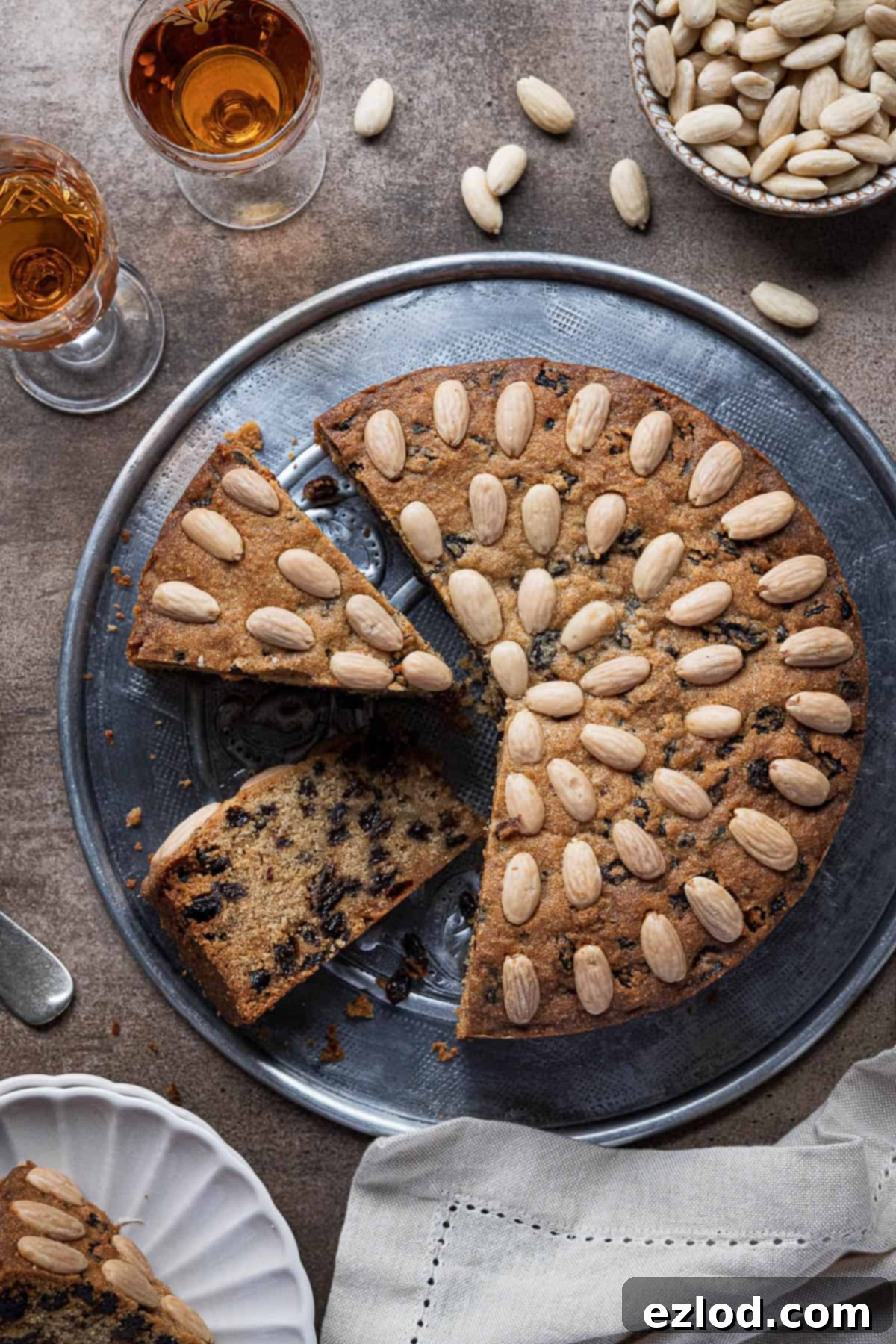
This vegan Dundee cake recipe presents a delightful, straightforward plant-based interpretation of the cherished traditional Scottish fruit cake. It captures all the essence and appeal of the original while being entirely suitable for a vegan diet. Each bite reveals a moist, tender crumb, generously studded with a medley of dried fruits and beautifully crowned with distinctive rings of blanched almonds. Whether you’re seeking a show-stopping dessert for a special occasion or simply a comforting treat to enjoy with your favourite hot beverage (or perhaps something a little stronger!) on a chilly afternoon, this cake is an absolute winner. Its elegant appearance and rich, zesty flavour make it a versatile addition to any table.
What Exactly Is Dundee Cake? A Taste of Scottish History
Dundee cake holds a special place in Scottish culinary heritage. This traditional fruit cake is distinct from other British fruit cakes, primarily due to its unique ingredients and presentation. Legend has it that the cake was originally created for Mary Queen of Scots. The story goes that she disliked glace cherries, which were common in fruit cakes of the era. To accommodate her preference, a new recipe emerged, substituting the usual cherries with blanched almonds for decoration and ground almonds in the batter, giving birth to the iconic Dundee cake we know today.
While the romantic tale of Mary Queen of Scots is charming, a more pragmatic and widely accepted theory attributes its development to Keiller’s marmalade company in Dundee, Scotland, during the 1700s. Faced with an abundance of Seville orange peels, the company sought innovative ways to utilise them, leading to the incorporation of Seville orange marmalade into the cake batter. This innovation proved pivotal, contributing to the cake’s signature moist texture and bright, zesty flavour profile.
Unlike its heavier Christmas cake cousins, a true Dundee cake adheres to specific characteristics. It should never contain glace cherries – the almond topping is paramount. Traditionally, it also avoids strong spices (though a hint of mixed spice can be a delightful, optional addition, as I prefer to include). Furthermore, authentic Dundee cake does not typically include added alcohol, making it a family-friendly choice. Its distinctive moistness comes from the inclusion of Seville orange marmalade and ground almonds within the batter, both contributing to its rich texture and flavour. The cake is instantly recognisable by its beautiful topping of concentric circles of blanched almonds, a simple yet elegant embellishment that sets it apart.
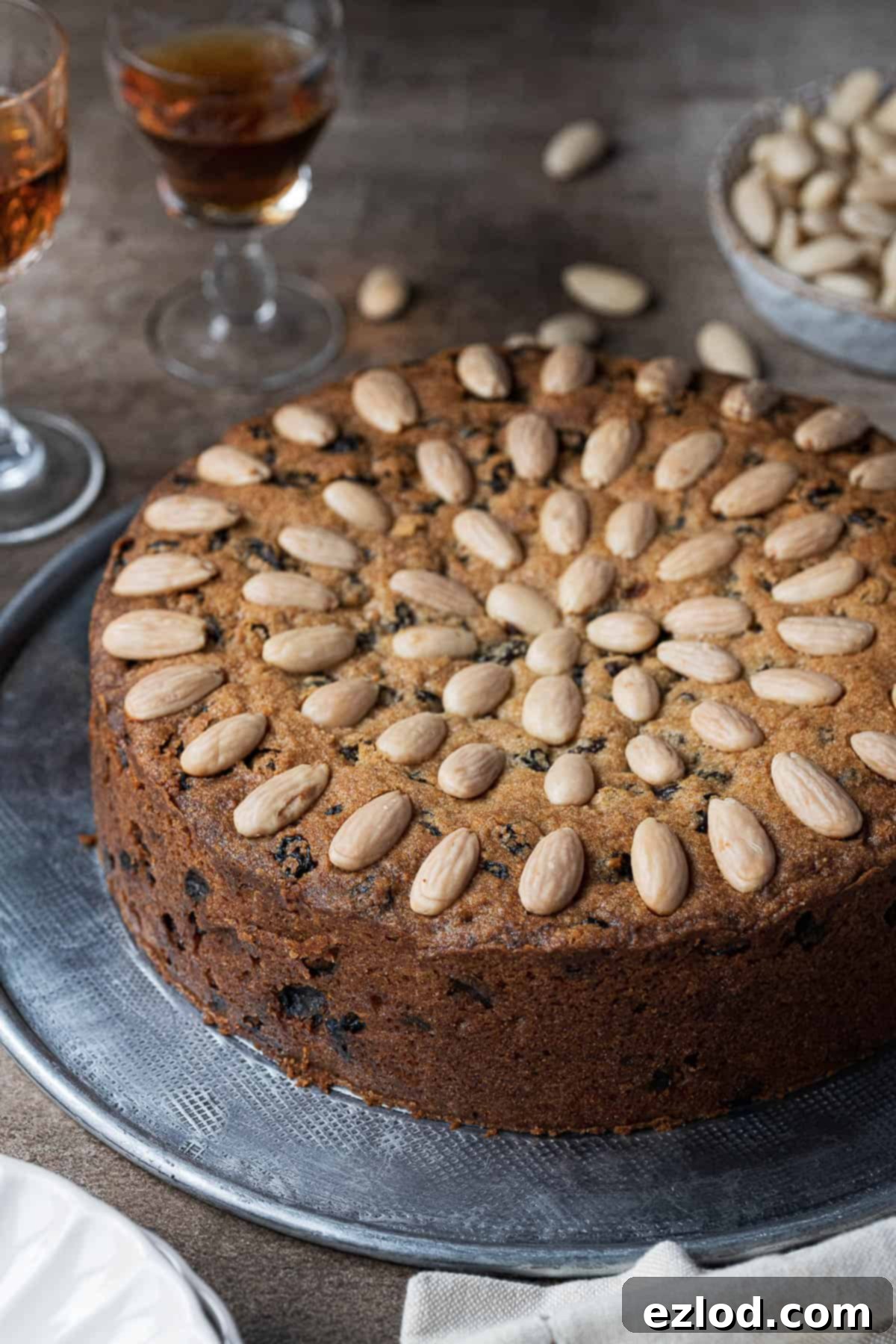
Why Choose a Vegan Dundee Cake?
Creating a vegan version of Dundee cake opens up this classic treat to a wider audience, catering to those with dietary restrictions or ethical preferences. By simply swapping dairy butter and milk for plant-based alternatives, we can achieve a cake that is just as rich, moist, and flavourful as the traditional recipe, without compromising on taste or texture. This vegan adaptation means that individuals following a plant-based diet, those with dairy allergies or intolerances, or anyone simply looking to reduce their consumption of animal products can fully enjoy this delightful Scottish specialty. It’s a testament to how traditional recipes can be thoughtfully adapted for modern dietary needs while retaining their authentic charm and deliciousness.
Essential Ingredients for Your Vegan Dundee Cake:
Crafting the perfect vegan Dundee cake relies on a few key ingredients, each playing a crucial role in achieving its signature taste and texture. Here’s a detailed look at what you’ll need:
- Marmalade: This is arguably the star ingredient. For the most authentic flavour and texture, a fine-shred Seville orange marmalade is highly recommended. Its distinct bittersweet notes and fine peel contribute significantly to the cake’s moistness and unique orange zest. Do not be tempted to omit this; it’s fundamental to the Dundee cake character. While other orange marmalades can be used, Seville marmalade truly provides that traditional depth.
- Ground and Blanched Almonds: Almonds are indispensable in a Dundee cake. Ground almonds (or almond flour in the US) are incorporated into the batter, adding richness, moisture, and a tender crumb. Blanched whole almonds, on the other hand, are artfully arranged in concentric circles on top of the cake before baking, providing the characteristic visual appeal and a lovely nutty crunch. While you could technically skip the blanched almond topping, it wouldn’t truly be a Dundee cake without this iconic decoration. These ingredients cannot be omitted for an authentic result.
- Vegan Block Butter: The type of vegan butter you use is critical. Opt for a block-style vegan butter or margarine, such as Naturli Vegan Block or Flora Plant Butter, which has a higher fat content and behaves similarly to dairy butter in baking. Avoid spreadable vegan butter from tubs, as their water content is too high and will negatively affect the cake’s texture, leading to a potentially greasy or dense result.
- Light Brown Sugar: Light brown soft or muscovado sugar is preferred for this recipe. It contributes to the cake’s light colour, moistness, and a subtle caramel note. Dark brown sugar will alter the colour too much, and its stronger molasses flavour might overpower the delicate orange and almond notes. It’s crucial not to substitute sugar with artificial sweeteners or liquid sugars, as sugar plays a vital structural role in the cake’s texture and moisture retention.
- Orange Zest: The finely grated zest of one large orange significantly boosts the cake’s citrus aroma and flavour, complementing the marmalade beautifully. While optional for some cakes, it’s highly recommended here for an authentic, vibrant taste. For an even more pronounced orange flavour, feel free to add the zest of a second orange.
- Plain (All-Purpose) Flour: Standard plain or all-purpose flour is ideal for this recipe, providing the necessary structure without being too dense. I do not recommend attempting this cake with gluten-free flour blends, as the specific combination of ingredients is designed around regular flour, and a gluten-free version is very likely to crumble apart and lose its desired moist yet sturdy texture.
- Baking Powder: This leavening agent is essential for giving the cake its lift and tender texture. It’s crucial not to swap baking powder for bicarbonate of soda (baking soda), as they react differently and require different acidic components in the batter to activate properly. Using the wrong one will lead to a dense or overly crumbly cake.
- Mixed Spice: While not strictly traditional for Dundee cake, a teaspoon of mixed spice (or apple pie spice/pumpkin spice in the US) adds a warming, subtle aromatic depth that many find appealing. This is entirely optional, so if you prefer a purely citrus-almond profile, feel free to omit it.
- Mixed Dried Fruit: A classic Dundee cake features a harmonious blend of sultanas, raisins, and currants. This combination provides a varied texture and sweetness throughout the cake. Candied peel can be an optional addition if you enjoy its intense citrusy chew. However, in keeping with tradition, glace cherries should be avoided, as their omission is a defining characteristic of Dundee cake.
- Unsweetened Non-Dairy Milk: Any unsweetened plant-based milk will work, but soy milk is often preferred due to its protein content, which can contribute to a slightly richer texture in baked goods. Ensure it is unsweetened to control the cake’s overall sweetness.
- A Pinch of Salt: A small amount of salt is vital for balancing the sweetness and enhancing all the other flavours in the cake. Don’t skip it!
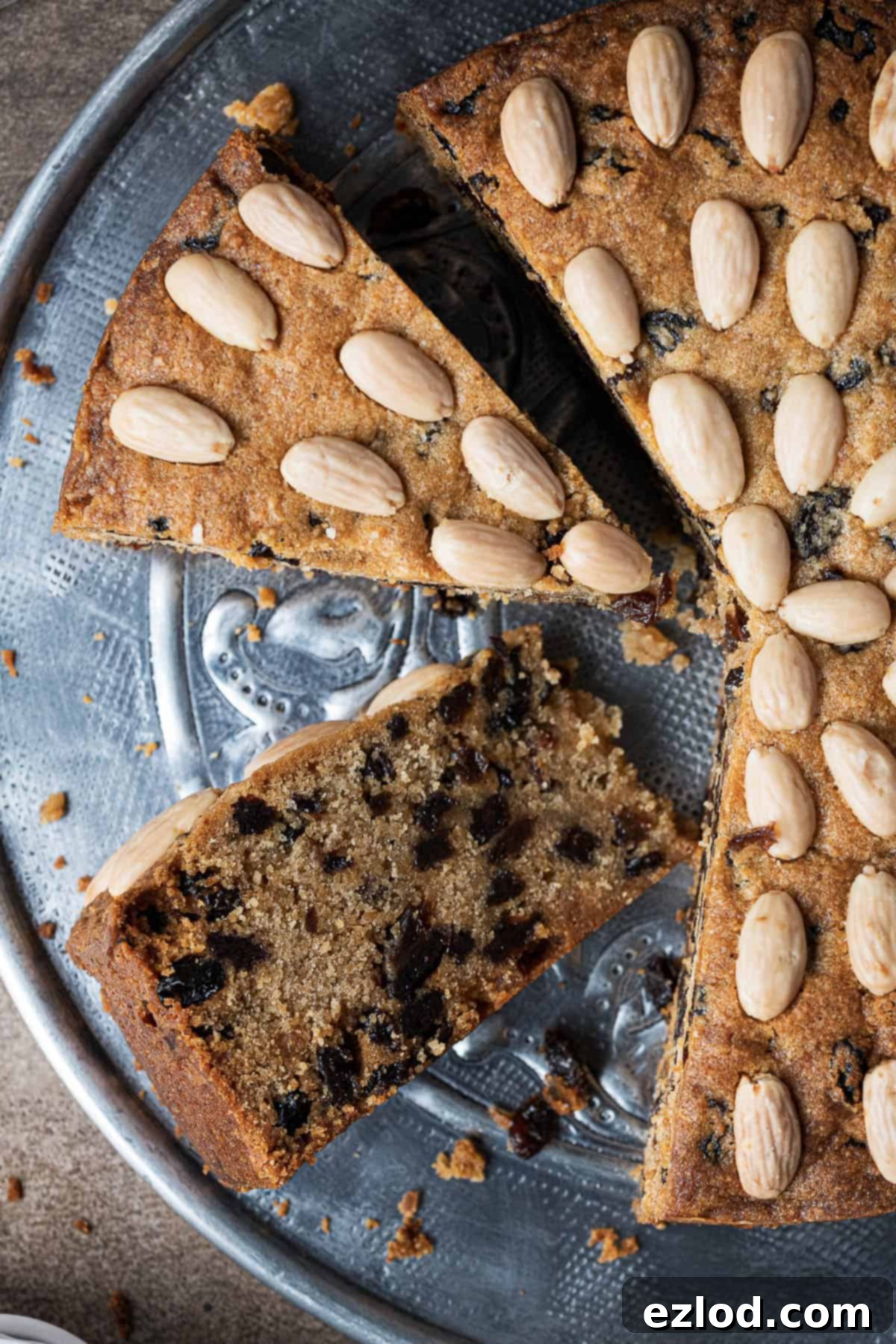
Crafting Your Vegan Dundee Cake: A Step-by-Step Guide
(For precise measurements and detailed instructions, please refer to the comprehensive recipe card located at the bottom of this page.)
- Prepare Your Tin: Begin by preheating your oven to 160°C (140°C fan/325°F/gas mark 3). This ensures your oven is at the correct temperature when the batter is ready. Thoroughly grease a 20 cm/8 inch round cake tin, approximately 9 cm/3.5 inches deep. Line both the base and sides with a double layer of baking parchment. It’s important that the parchment extends a couple of centimetres (or one inch) above the rim of the tin. This double lining acts as insulation, preventing the edges of the cake from over-browning or burning before the centre is fully cooked, which is especially important for a longer baking cake like this.
- Cream Butter and Sugar: In a large mixing bowl, combine the slightly softened vegan block butter with the light brown sugar. Using an electric mixer, whisk these two ingredients together until the mixture becomes wonderfully smooth, light, and creamy. This creaming process incorporates air, which is crucial for a tender cake texture.
- Introduce Marmalade and Zest: Next, add the fine shred Seville orange marmalade and the finely grated orange zest to the creamed butter and sugar mixture. Continue to whisk with the electric mixer until all ingredients are well combined and evenly distributed, imparting a lovely orange fragrance throughout the mix.
- Combine Dry and Wet Ingredients: Into the bowl, add the plain (all-purpose) flour, ground almonds, baking powder, the optional mixed spice, unsweetened non-dairy milk, and a pinch of salt. Mix on a low speed, or by hand with a spatula, until the ingredients are just combined and form a smooth, thick batter. Be careful not to over-beat the batter at this stage; overmixing can develop the gluten in the flour too much, leading to a tough cake. Stop mixing as soon as everything is incorporated.
- Fold in Dried Fruit: Gently fold the mixed dried fruit (sultanas, raisins, and currants) into the batter using a spatula. Ensure the fruit is evenly distributed throughout the mixture without crushing it.
- Prepare for Baking: Carefully transfer the prepared cake batter into your double-lined cake tin. Use the back of a wet spoon to gently spread the batter level and smooth out the top surface. This helps create an even bake and a neat finish.
- Adorn with Almonds: Arrange the whole blanched almonds on top of the cake batter in the classic concentric circles pattern. Press them very lightly into the batter – just enough to secure them without submerging them. This decorative step is quintessential to a Dundee cake’s appearance.
- Bake to Perfection: Place the cake in the preheated oven and bake for approximately 2 hours. The cake is done when a skewer inserted into the very centre comes out clean, or with a few moist crumbs attached but no wet batter. If you notice the top of the cake browning too quickly before it’s fully cooked, loosely cover it with a piece of tin foil to prevent further darkening. Critically, avoid opening the oven door for at least the first 1.5 hours of baking, as sudden temperature changes can cause the cake to sink in the middle.
- Cool Completely: Once baked, remove the cake from the oven and let it cool completely within its tin on a wire rack. This gradual cooling process helps the cake to set properly and prevents it from crumbling. Once fully cooled, turn it out and store it in an airtight container to maintain its freshness.
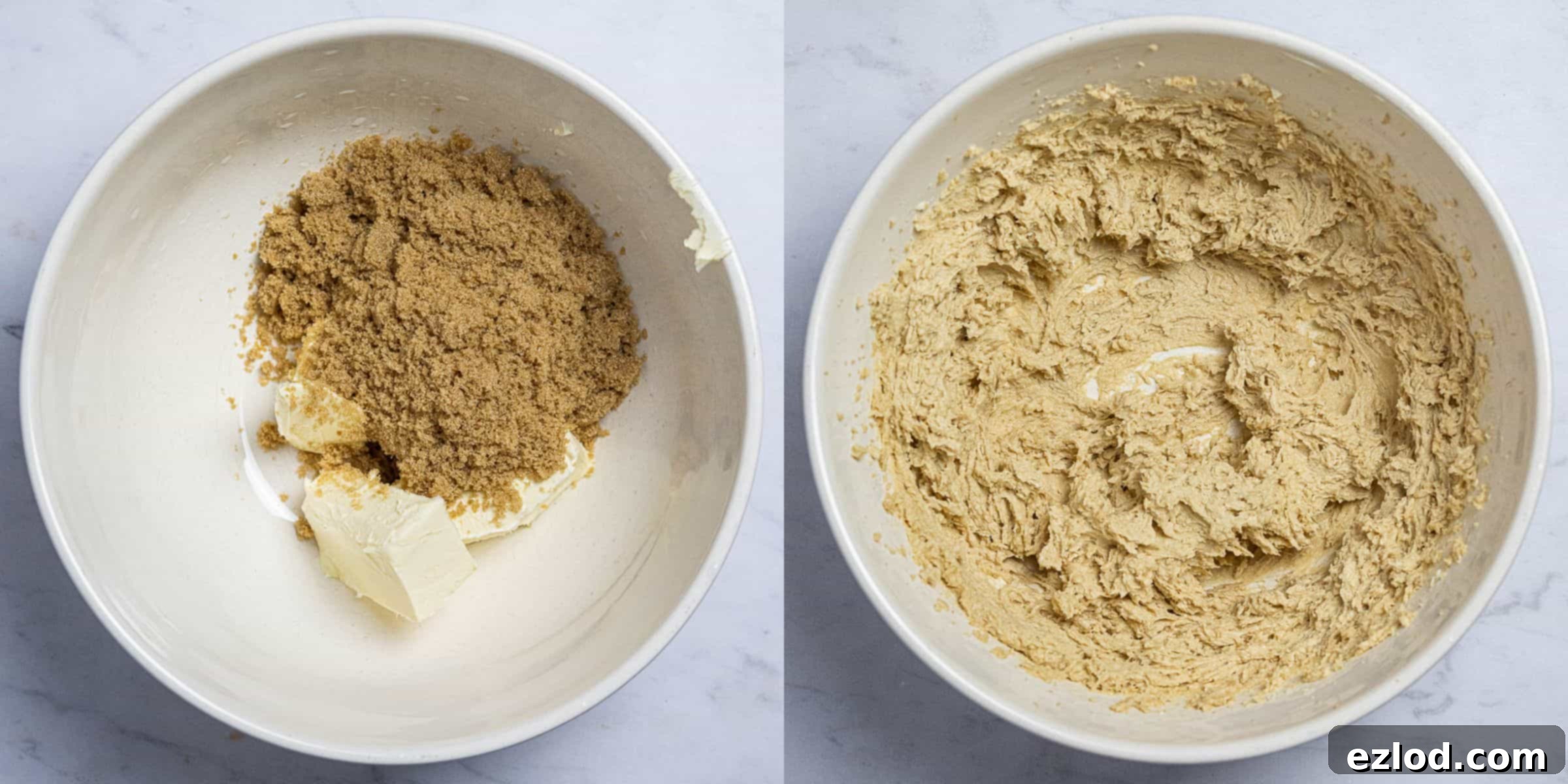
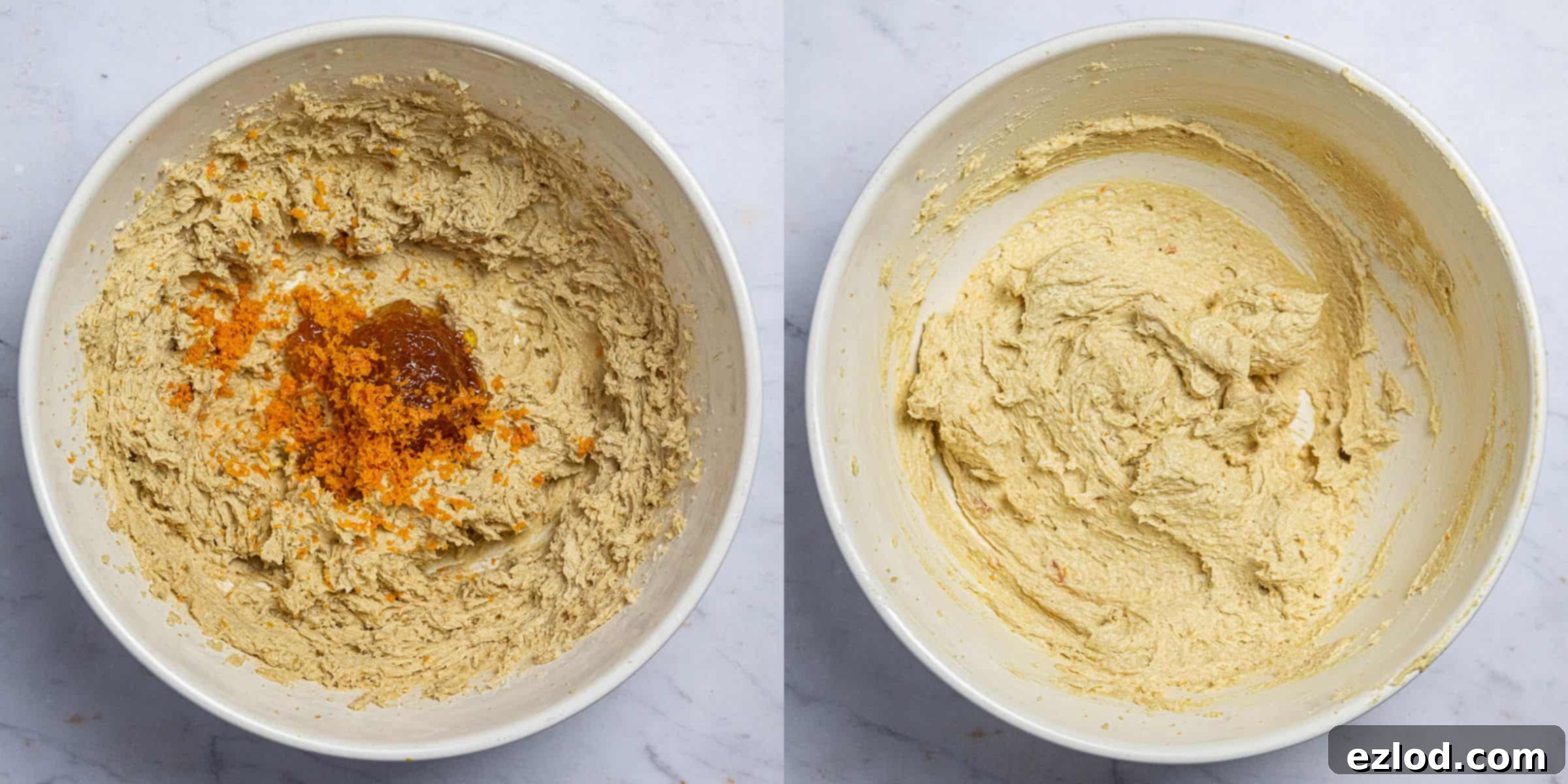
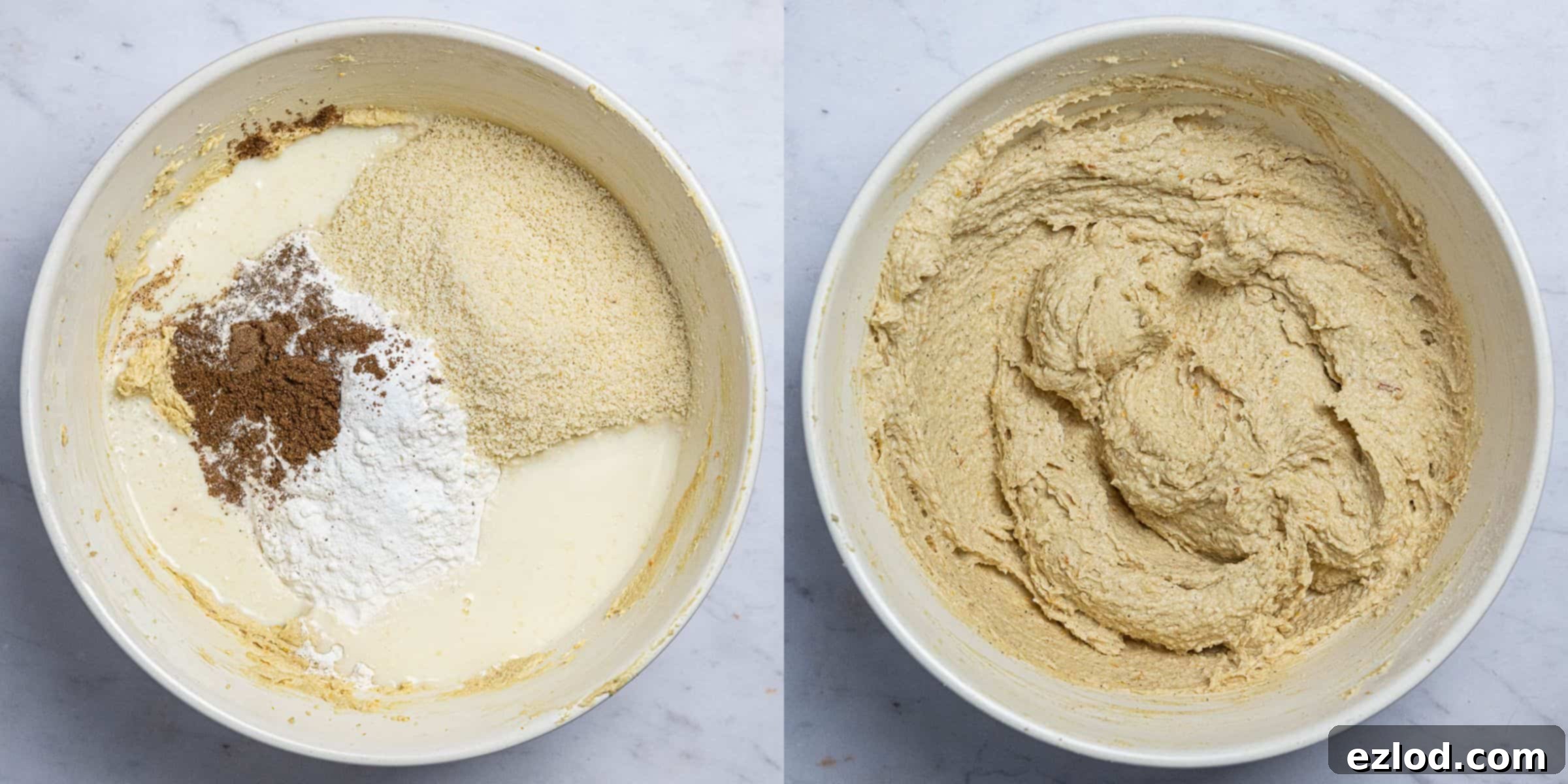
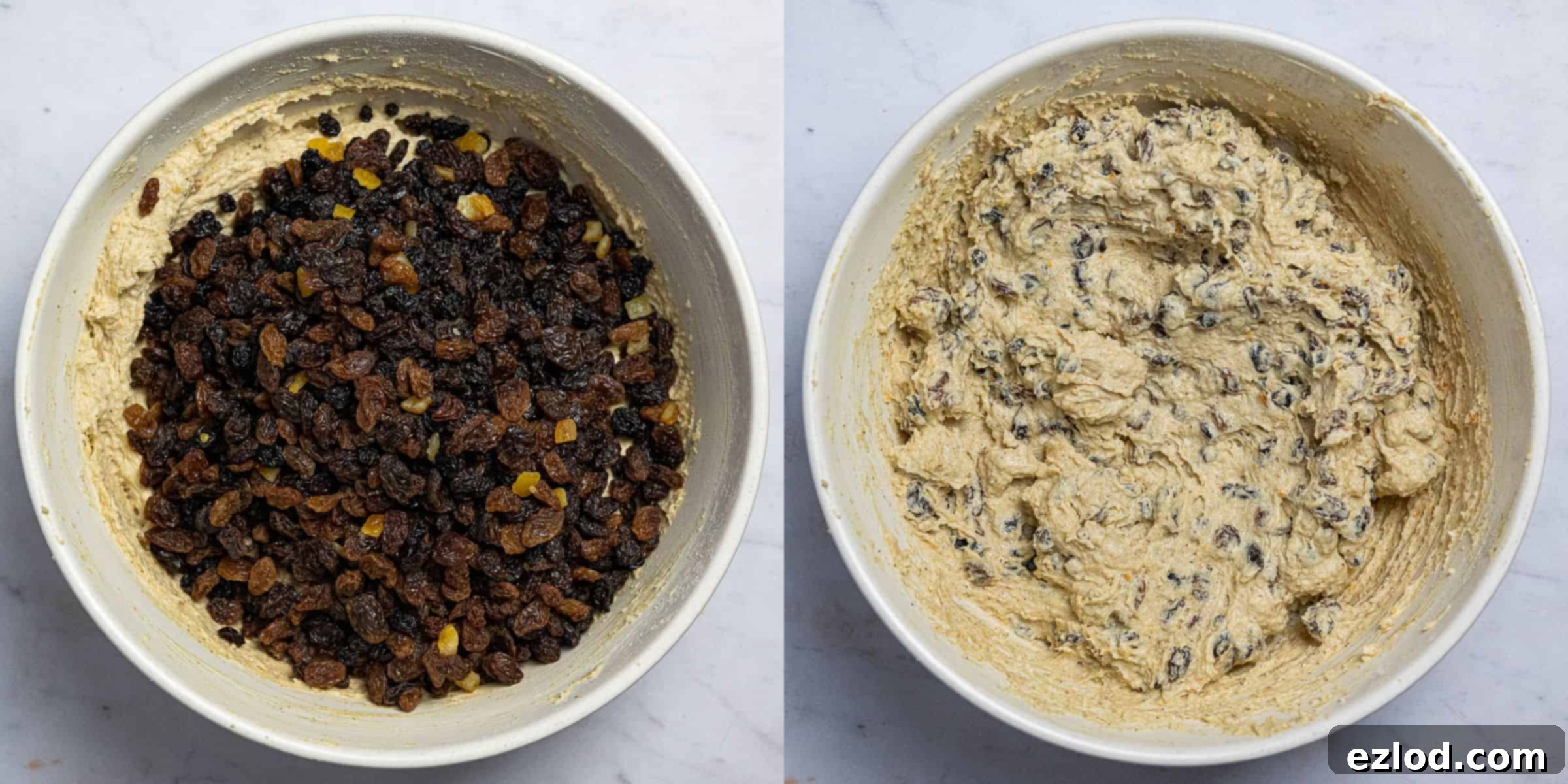
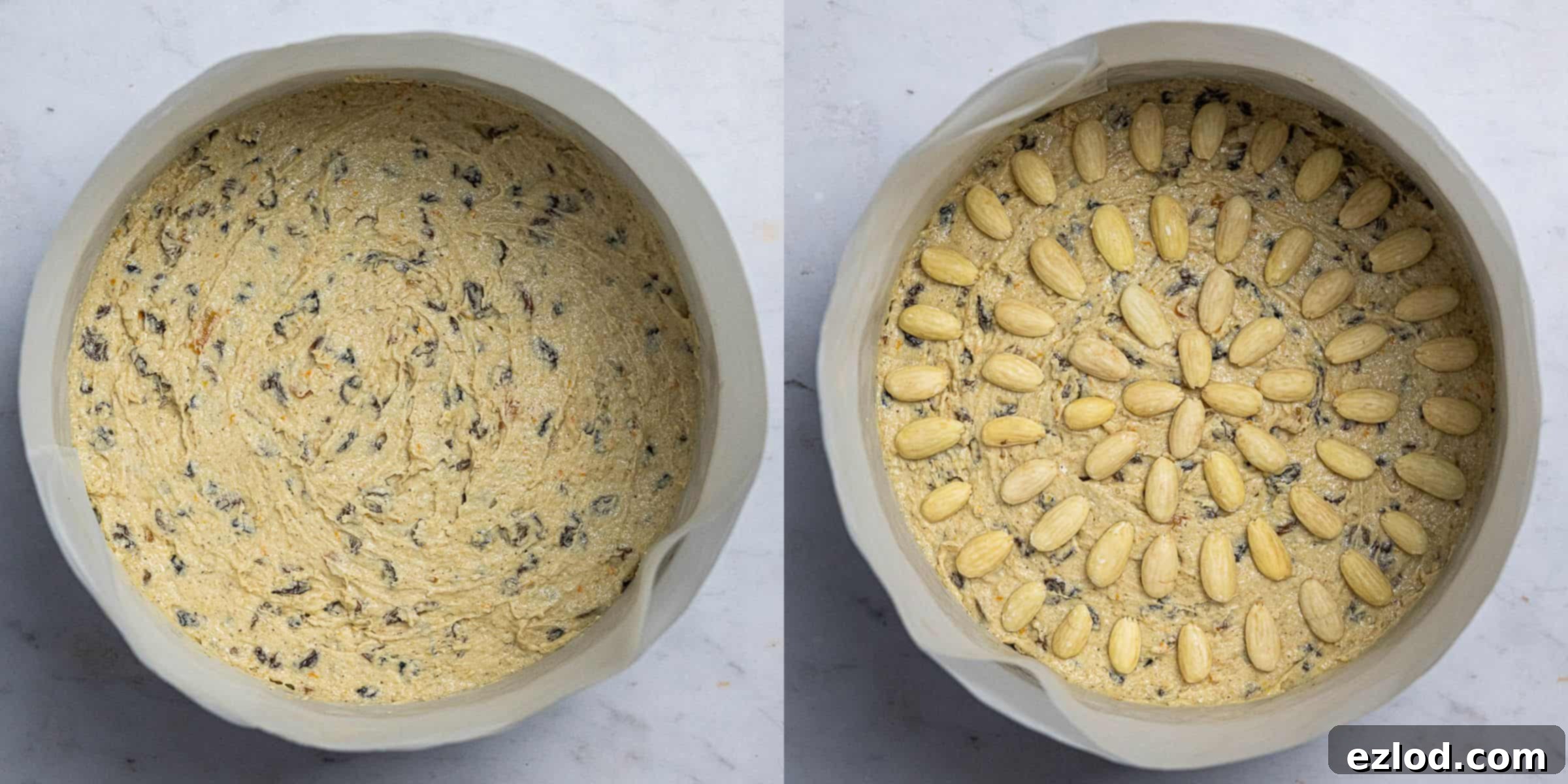
Top Tips for Vegan Dundee Cake Success:
Achieving a perfect vegan Dundee cake is straightforward with a few key considerations:
- Measure with Precision: As with all baking, I cannot stress enough the importance of using metric measurements with a digital kitchen scale rather than cup conversions. Cups are notoriously inaccurate and inconsistent, leading to varying results. A scale ensures precise measurements every time, resulting in a more reliable and delicious outcome, not to mention less mess!
- Follow the Recipe Closely: For the very best results, adhere to the recipe as written. Each ingredient and step has been carefully selected to contribute to the cake’s flavour and texture. Altering ingredients or proportions without understanding the baking science behind them can significantly impact the final product, potentially leading to a dry, dense, or crumbly cake.
- Proper Tin Lining: The instruction to line your cake tin with a double layer of baking parchment is not merely decorative. This extra layer acts as insulation, crucial for preventing the edges of the cake from burning or becoming overly dry before the denser centre has had a chance to cook through evenly.
- Patience with Baking: Resist the urge to open the oven door during the first hour and a half of baking. Fluctuations in oven temperature can cause the cake to sink dramatically in the middle. Let the cake bake undisturbed for the recommended time before checking for doneness.
- Checking for Doneness: The cake is perfectly baked when it feels firm to the touch and a thin skewer inserted into the centre emerges clean, or with just a few moist crumbs attached. If you see wet batter, it needs more time. Don’t worry if there’s a slight dip in the middle; this is quite normal for a Dundee cake.
- Cooling is Key: Ensure the cake cools completely in its tin on a wire rack before you attempt to slice it. Slicing a warm fruit cake can cause it to crumble and lose its structure, as the internal components are still setting. Patience here will be rewarded with neat, firm slices.
- Room Temperature Ingredients: For optimal emulsion and a smooth batter, ensure your vegan butter and any liquid ingredients (like non-dairy milk) are at room temperature. This helps them combine more easily and creates a more uniform batter.
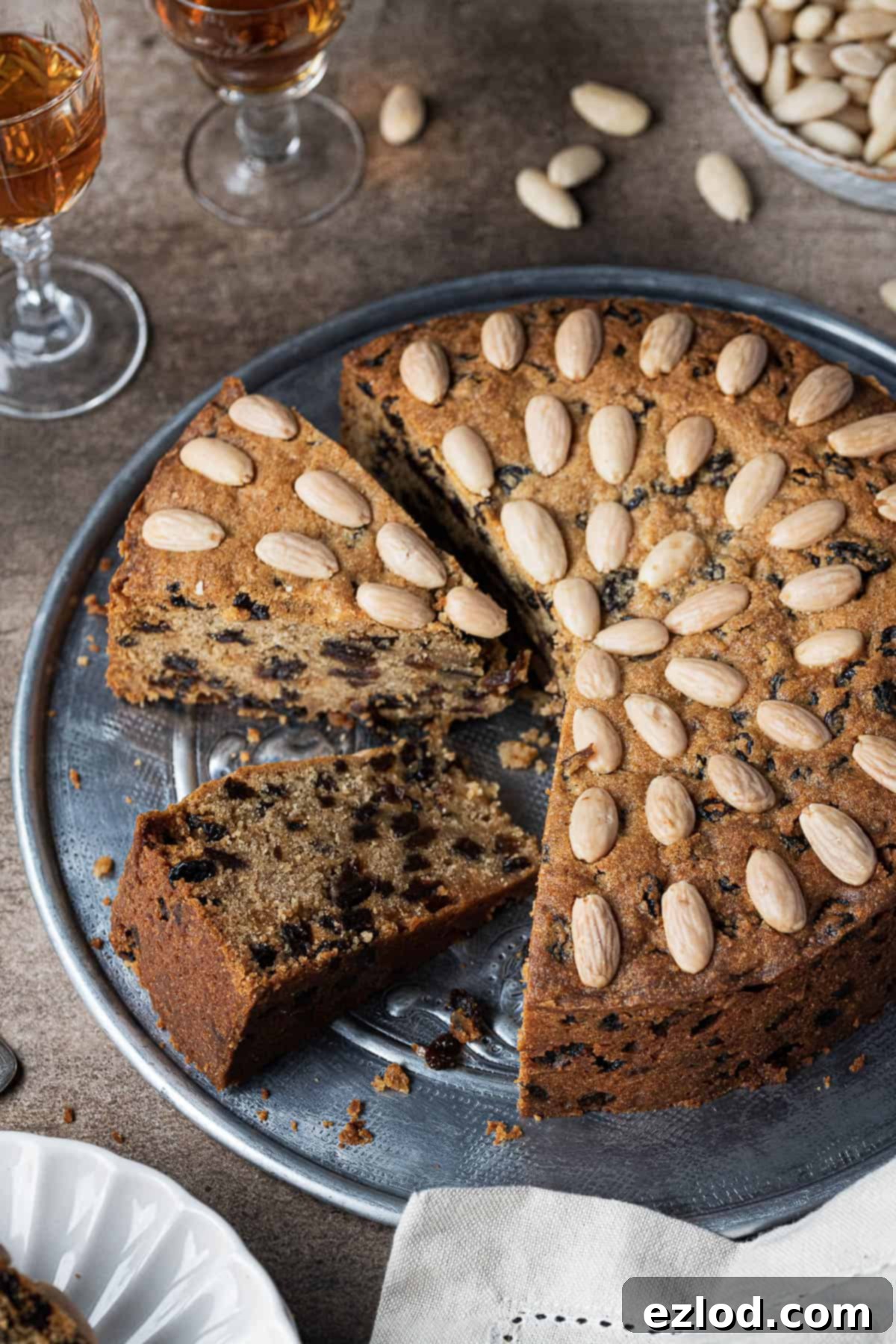
Storing Your Vegan Dundee Cake:
One of the many appealing qualities of a Dundee cake is its excellent keeping properties. This vegan version will stay fresh and delicious when stored in an airtight container at room temperature for up to two weeks. While it has good longevity, it’s important to note that it’s not designed to keep for as long as a heavily alcohol-fed traditional Christmas cake.
If you wish to extend its shelf life further, you have a couple of options. For longer storage, tightly wrap the cooled cake in baking parchment, then in foil, and place it back in an airtight container. You can choose to “feed” it with a drizzle of whisky every couple of weeks, similar to traditional fruit cakes, if you enjoy that flavour profile. This isn’t essential but can enhance its complexity over time. Alternatively, this vegan Dundee cake freezes exceptionally well. Wrap individual slices or the whole cake tightly in multiple layers of cling film and then foil, and freeze for up to three months. Thaw overnight in the refrigerator or at room temperature before serving.
Should You Soak the Fruit in Advance?
For this vegan Dundee cake, I typically do not find it necessary to soak the dried fruit in advance, and it’s not a traditional step for Dundee cake either. The beauty of this recipe is that the fruit remains moist and plump by absorbing steam as the cake bakes, resulting in a perfectly succulent texture without any pre-treatment. The marmalade and ground almonds also contribute significantly to the cake’s overall moistness, ensuring the fruit doesn’t dry out.
If you were to choose to soak the fruit, there’s a distinct risk that the added moisture could make the cake too wet, potentially leading to a dense texture or causing it to sink in the middle. The balance of liquids in this recipe is quite precise. However, if you are keen to experiment with soaking, I recommend a very conservative approach: use only about 3 tablespoons of alcohol (such as brandy or whisky) or orange juice. Ensure the fruit fully absorbs this liquid, ideally by letting it soak for at least a day, or until no excess liquid remains. To counteract any potential extra moisture, you might also consider slightly increasing the flour to approximately 280g. Please note, I haven’t personally tested this cake with pre-soaked fruit, so proceeding with this modification is at your own discretion and risk.
Serving Suggestions for Your Vegan Dundee Cake
This versatile vegan Dundee cake is a delight on its own, but it also pairs beautifully with a variety of accompaniments. For a classic afternoon tea experience, serve a generous slice with a fresh cup of Earl Grey or Darjeeling. On a colder evening, it’s wonderfully comforting alongside a steaming mug of coffee or a warming glass of whisky – a nod to its Scottish roots. For a more decadent dessert, consider serving it with a dollop of vegan whipped cream, a scoop of vanilla bean plant-based ice cream, or even a light drizzle of vegan custard. Its rich, fruity, and zesty notes make it suitable for any time of day and any occasion, from a simple snack to a festive dessert.
Explore More Vegan British & Christmas Recipes:
If you’ve enjoyed this vegan Dundee cake, you’ll be thrilled to discover a wealth of other plant-based delights on the blog, perfect for various occasions, especially during the festive season. Here’s a curated selection of some popular vegan British and Christmas-themed recipes to inspire your next baking adventure:
- Vegan Christmas Cake: A rich, traditional cake brimming with fruit, perfect for holiday celebrations.
- Vegan Viennese Whirl Mince Pies: A charming twist on classic mince pies, featuring delicate shortbread swirls.
- Vegan Gingerbread Cookies: Perfectly spiced and wonderfully chewy, ideal for decorating and gifting.
- Vegan Christmas Pudding: The quintessential festive dessert, moist and aromatic.
- Vegan Mincemeat Cake: A delightful cake that captures all the flavours of mincemeat in a lighter form.
- Vegan Shortbread Fingers: Buttery, crumbly, and melt-in-your-mouth Scottish shortbread.
- Easy Vegan Ginger Cake: A comforting and warmly spiced cake, simple to prepare.
- Vegan Steamed Chocolate Pudding: A rich, decadent, and incredibly satisfying dessert.
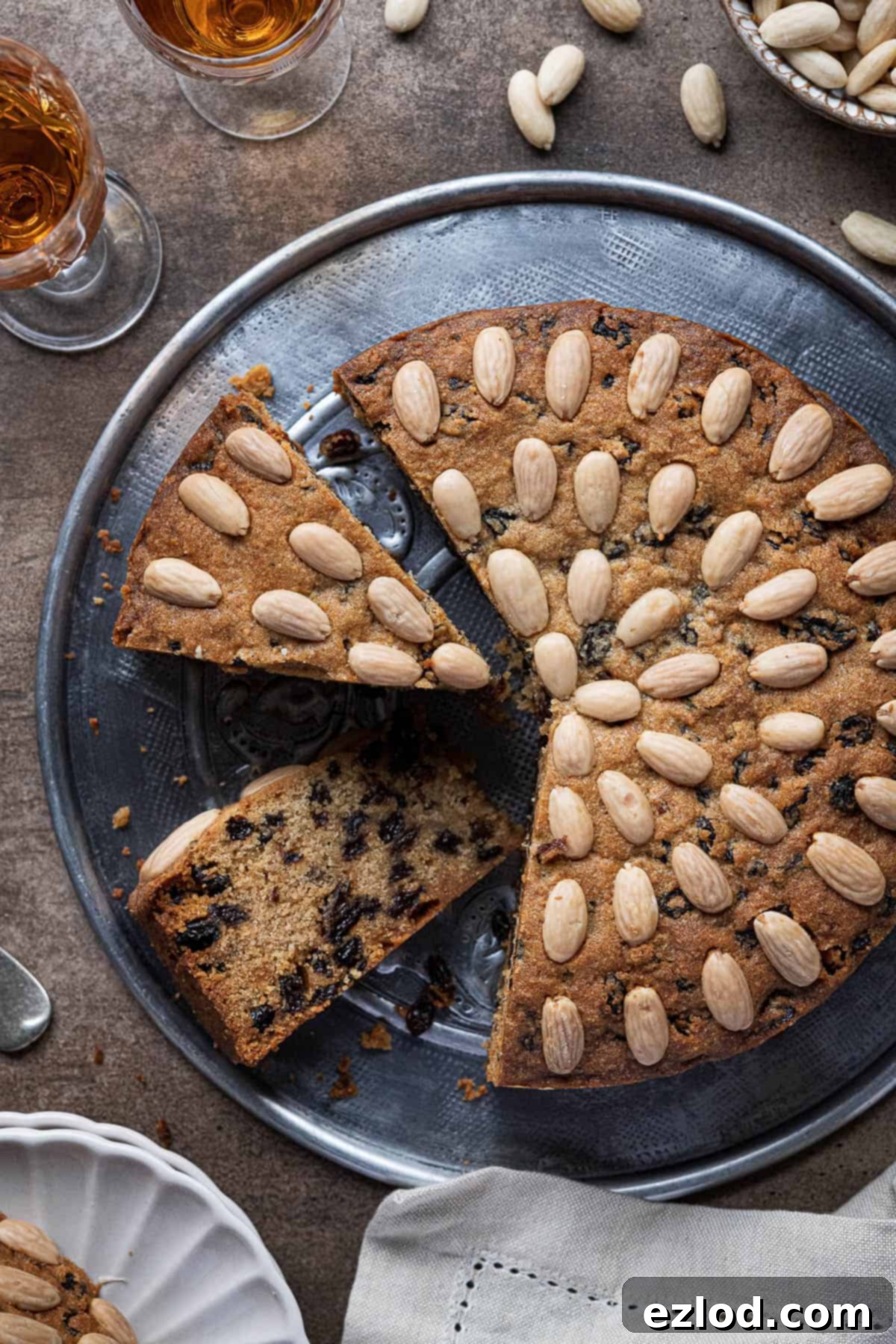
If you tried this delightful Vegan Dundee Cake recipe, I would love to hear how it turned out! Please take a moment to rate it and leave a comment below. You can also share your creations on Instagram by tagging @domestic_gothess and using the hashtag #domesticgothess. Your feedback is greatly appreciated!
All images and content featured on Domestic Gothess are protected by copyright. If you wish to share this recipe, please do so by utilising the provided share buttons. Kindly refrain from screenshotting or posting the recipe or its content in full. Instead, a direct link back to this post for the complete recipe is preferred and respectful. Thank you for your understanding and support!

Print
Vegan Dundee Cake
Ingredients
- 180 g (¾ cup) vegan block butter (I use Naturli Vegan Block) slightly softened
- 180 g (1 cup) light brown soft/muscovado sugar
- 100 g (4 Tablespoons) fine shred Seville orange marmalade
- finely grated zest of 1 large orange
- 260 g (2 cups + 2 Tablespoons) plain (all-purpose) flour
- 100 g (3 ½ oz) ground almonds (almond flour)
- 1 teaspoon baking powder
- 1 teaspoon mixed spice (optional)
- 135 ml (½ cup + 1 Tablespoon) unsweetened non-dairy milk (I use soy)
- a pinch of salt
- 500 g (17 oz) mixed dried fruit (sultanas, raisins, currants)
- about 100 g (3 ½ oz) whole blanched almonds
Instructions
-
Preheat the oven to 160°C/140°C fan/325°F/gas mark 3. Grease a 20 cm/8 in round, approx 9 cm/3 ½ in deep cake tin and line the base and sides with a double layer of baking parchment, making sure that it comes above the top of the tin by a couple of cm/1 inch.
-
Whisk together the butter and sugar with an electric mixer until smooth and creamy then whisk in the marmalade and orange zest.
-
Add the flour, ground almonds, baking powder, mixed spice, milk and a pinch of salt and mix to form a smooth, thick batter. Don’t over-beat it, just mix until it is fully combined then stop.
-
Add the dried fruit and fold through.
-
Transfer the batter to the prepared tin and spread it level. Use the back of a wet spoon to smooth the top.
-
Arrange the blanched almonds in circles on top of the cake. Press them only very lightly into the batter.
-
Bake the cake for about 2 hours until a skewer inserted into the centre comes out clean. If the top of the cake starts to get too dark before it is cooked then you can loosely cover it with a piece of tin foil. Do not open the oven door until the cake has been baking for at least 1 ½ hours however.
-
Leave the cake to cool in the tin completely then turn out and store in an airtight container.
Notes
- See post above for tips, details, storage instructions and step-by-step photos.
- As with all of my baking recipes I really do recommend using the metric measurements with a digital scale rather than the cup conversions. Cups are a wildly inaccurate measuring system and you will get far better, more consistent results using a scale, not to mention that it is also easier and less messy than cups!
- The cake is ready when it is firm to the touch and a skewer inserted into the centre comes out clean or with a few moist crumbs but no wet batter.
- It is normal for the cake to have a slight dip in the middle.
- Make sure that the cake has cooled completely before you slice it.
